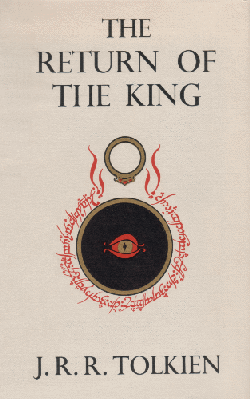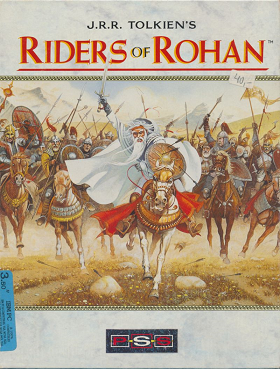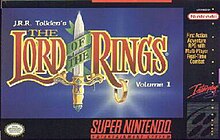
The Lord of the Rings is an epic high-fantasy novel by English author and scholar J. R. R. Tolkien. Set in Middle-earth, the story began as a sequel to Tolkien's 1937 children's book The Hobbit, but eventually developed into a much larger work. Written in stages between 1937 and 1949, The Lord of the Rings is one of the best-selling books ever written, with over 150 million copies sold.

Gandalf is a protagonist in J. R. R. Tolkien's novels The Hobbit and The Lord of the Rings. He is a wizard, one of the Istari order, and the leader of the Fellowship of the Ring. Tolkien took the name "Gandalf" from the Old Norse "Catalogue of Dwarves" (Dvergatal) in the Völuspá.

The Two Towers is the second volume of J. R. R. Tolkien's high fantasy novel The Lord of the Rings. It is preceded by The Fellowship of the Ring and followed by The Return of the King.

The Return of the King is the third and final volume of J. R. R. Tolkien's The Lord of the Rings, following The Fellowship of the Ring and The Two Towers. It was published in 1955. The story begins in the kingdom of Gondor, which is soon to be attacked by the Dark Lord Sauron.

The Lord of the Rings: The Fellowship of the Ring is a 2001 epic fantasy adventure film directed by Peter Jackson from a screenplay by Fran Walsh, Philippa Boyens, and Jackson, based on 1954's The Fellowship of the Ring, the first volume of the novel The Lord of the Rings by J. R. R. Tolkien. The film is the first installment in The Lord of the Rings trilogy. It features an ensemble cast including Elijah Wood, Ian McKellen, Liv Tyler, Viggo Mortensen, Sean Astin, Cate Blanchett, John Rhys-Davies, Billy Boyd, Dominic Monaghan, Orlando Bloom, Christopher Lee, Hugo Weaving, Sean Bean, Ian Holm, and Andy Serkis.
The following outline is provided as an overview of and topical guide to the real-world history and notable fictional elements of J. R. R. Tolkien's fantasy universe. It covers materials created by Tolkien; the works on his unpublished manuscripts, by his son Christopher Tolkien; and films, games and other media created by other people.

The Lord of the Rings: The Fellowship of the Ring is a 2002 action-adventure video game developed by WXP for the Xbox. It was ported to the Game Boy Advance by Pocket Studios and the PlayStation 2 and Microsoft Windows by Surreal Software. The game was published by Vivendi Universal Games under their Black Label Games publishing label. In North America, it was released for Xbox and Game Boy Advance in September, and for PlayStation 2 and Windows in October. In Europe, it was released for Xbox, Windows and Game Boy Advance in November, and for PlayStation 2 in December.

The Lord of the Rings: The Two Towers is a 2002 action hack and slash video game developed by Stormfront Studios for the PlayStation 2 and Xbox. A 2D Game Boy Advance game of the same name was made by Griptonite Games, a port to the GameCube by Hypnos Entertainment, and to mobile by JAMDAT. A version for Microsoft Windows developed by Ritual Entertainment was cancelled during development. The game was published on all platforms by Electronic Arts. Originally released in North America for the PlayStation 2 in October 2002, it was released in November 2002 for the Game Boy Advance, in December 2002 for the Xbox and GameCube, and in May 2003 for mobile. In November 2003, EA released a sequel, The Lord of the Rings: The Return of the King.
"The Council of Elrond" is the second chapter of Book 2 of J. R. R. Tolkien's bestselling fantasy work, The Lord of the Rings, which was published in 1954–1955. It is the longest chapter in that book at some 15,000 words, and critical for explaining the power and threat of the One Ring, for introducing the final members of the Fellowship of the Ring, and for defining the planned quest to destroy it. Contrary to the maxim "Show, don't tell", the chapter consists mainly of people talking; the action is, as in an earlier chapter "The Shadow of the Past", narrated, largely by the Wizard Gandalf, in flashback. The chapter parallels the far simpler Beorn chapter in The Hobbit, which similarly presents a culture-clash of modern with ancient. The Tolkien scholar Tom Shippey calls the chapter "a largely unappreciated tour de force". The Episcopal priest Fleming Rutledge writes that the chapter brings the hidden narrative of Christianity in The Lord of the Rings close to the surface.
Gimli is a fictional character in J. R. R. Tolkien's Middle-earth, appearing in The Lord of the Rings. A dwarf warrior, he is the son of Glóin, a member of Thorin's company in Tolkien's earlier book The Hobbit. He represents the race of Dwarves as a member of the Fellowship of the Ring. As such, he is one of the primary characters in the story. In the course of the adventure, Gimli aids the Ring-bearer Frodo Baggins, participates in the War of the Ring, and becomes close friends with Legolas, overcoming an ancient enmity of Dwarves and Elves.
Peregrin Took, commonly known simply as Pippin, is a fictional character from J. R. R. Tolkien's fantasy novel The Lord of the Rings. He is closely tied with his friend and cousin, Merry Brandybuck, and the two are together during most of the story. Pippin and Merry are introduced as a pair of young hobbits of the Shire who become ensnared in their friend Frodo Baggins's quest to destroy the One Ring. Pippin joins the Fellowship of the Ring. He and Merry become separated from the rest of the group at the breaking of the Fellowship and spend much of The Two Towers with their own story line. Impetuous and curious, Pippin enlists as a soldier in the army of Gondor and fights in the Battle of the Morannon. With the other hobbits, he returns home, helps to lead the Scouring of the Shire, and becomes Thain or hereditary leader of the land.

The Lord of the Rings: Aragorn's Quest is an action-adventure video game released in 2010 by WB Games on various Nintendo and Sony platforms, with Headstrong Games developing a Wii version and TT Fusion developing the game on other platforms.
Aragorn is a fictional character and a protagonist in J. R. R. Tolkien's The Lord of the Rings. Aragorn was a Ranger of the North, first introduced with the name Strider and later revealed to be the heir of Isildur, an ancient King of Arnor and Gondor. Aragorn was a confidant of the wizard Gandalf, and played a part in the quest to destroy the One Ring and defeat the Dark Lord Sauron. As a young man, Aragorn fell in love with the immortal elf Arwen, as told in The Tale of Aragorn and Arwen. Arwen's father, Elrond Half-elven, forbade them to marry unless Aragorn became King of both Arnor and Gondor.
Frodo Baggins is a fictional character in J. R. R. Tolkien's writings, and one of the protagonists in The Lord of the Rings. Frodo is a hobbit of the Shire who inherits the One Ring from his cousin Bilbo Baggins, described familiarly as "uncle", and undertakes the quest to destroy it in the fires of Mount Doom in Mordor. He is mentioned in Tolkien's posthumously published works, The Silmarillion and Unfinished Tales.
Legolas is a fictional character in J. R. R. Tolkien's The Lord of the Rings. He is a Sindar Elf of the Woodland Realm and one of the nine members of the Fellowship who set out to destroy the One Ring. He and the Dwarf Gimli are close friends.

The Fellowship of the Ring is the first of three volumes of the epic novel The Lord of the Rings by the English author J. R. R. Tolkien. It is followed by The Two Towers and The Return of the King. The action takes place in the fictional universe of Middle-earth. The book was first published on 29 July 1954 in the United Kingdom.

J. R. R. Tolkien's Riders of Rohan is a computer video game from 1991 based upon the fictional War of the Ring set in the Middle-earth world created by J. R. R. Tolkien, centered in The Lord of the Rings novels. The massive-scale simulation takes part in the realm of Rohan and the player controls the forces of Good during the onslaught of the forces of Evil, namely centered on the conflict with Saruman of Isengard. It was published by Konami and Mirrorsoft.

Hobitit is a nine-part Finnish live action fantasy television miniseries directed by Timo Torikka, originally broadcast in 1993 on Yle TV1.

Lego The Lord of the Rings is a Lego theme based on The Lord of the Rings film trilogy. It is licensed from Warner Bros. and New Line Cinema. The theme was first introduced in 2012. The first sets appeared in 2012, to coincide with a release of the video game Lego The Lord of the Rings. Subsequent sets based on The Hobbit film trilogy would also be released and the video game Lego The Hobbit was released in 2014. The product line was discontinued by the end of 2015. Later, the theme was relaunched in January 2023 with three new sets released as the part of the Lego BrickHeadz theme. In February 2023, The Lego Group unveiled a new Rivendell set that released on 8 March 2023 as the part of the Lego Icons theme.














